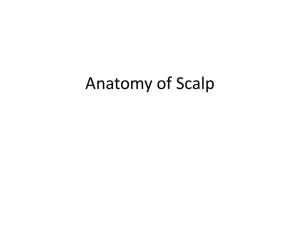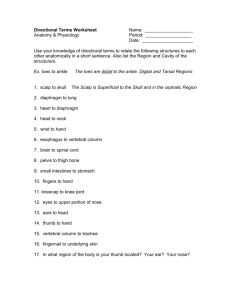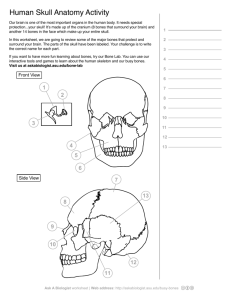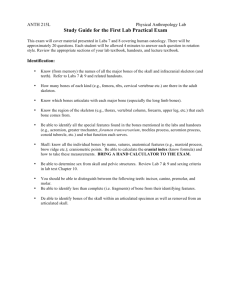ppt
advertisement
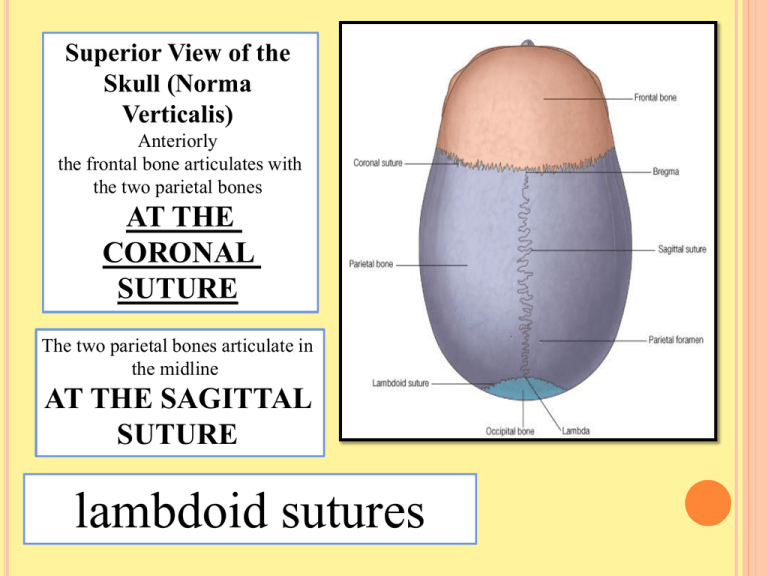
Superior View of the Skull (Norma Verticalis) Anteriorly the frontal bone articulates with the two parietal bones AT THE CORONAL SUTURE The two parietal bones articulate in the midline AT THE SAGITTAL SUTURE lambdoid sutures To assist one in memorizing the names of the five layers of the scalp, use each letter of the word SCALP to denote the layer of the scalp. P—periosteum The Scalp The scalp consists of FIVE LAYERS S-skin C-connective tissue (dense) A-aponeurotic layer L-loose connective tissue P-pericranium The first three of which are intimately bound together and move as a unit 1-Skin is thick contains hair and contains numerous sebaceous glands Sebaceous cyst 2-Connective tissue Made of fibrous fascia and septa which unite the skin to the underlying aponeurosis of the occipitofrontalis muscle Contains numerous arteries and veins!!! It is often difficult to stop the bleeding of a scalp wound because the arterial walls are attached to fibrous septa in the subcutaneous tissue and are unable to contract or retract to allow blood clotting to take place Local pressure applied to the scalp is the only satisfactory method of stopping the bleeding 3-Aponeurosis (epicranial), is a thin, tendinous sheet that unites the occipital and frontal bellies of the occipitofrontalis muscle Epicranail aponeurosis The lateral margins of the aponeurosis are attached to the temporal fascia. The subaponeurotic space is the potential space beneath the epicranial aponeurosis. It is limited in front and behind by the origins of the occipitofrontalis muscle, and it extends laterally as far as the attachment of the aponeurosis to the temporal fascia The tension of the epicranial aponeurosis, produced by the tone of the occipitofrontalis muscles, is important in all deep wounds of the scalp. If the aponeurosis has been divided, the wound will gape open. For satisfactory healing to take place, the opening in the aponeurosis must be closed with sutures 4-Loose areolar tissue Also called the dangerous area Of the scalp Black eyes …..think of head trauma Made of loose areolar tissue which contains important emissary veins. The emissary veins are valveless and connect The superficial veins of the scalp with the diploic veins of the skull bones Causing Osteomyelitis Infected blood in the diploic veins may travel by the emissary veins farther into the venous sinuses and produce venous sinus thrombosis 5-Pericranium is the periosteum covering the outer surface of the skull bones. The sutures between individual skull bones, the periosteum on the outer surface of the bones becomes continuous with the periosteum on the inner surface of the skull bones . THEREFORE if there is any fluid collection beneath the pericranium (Cephalhaematoma) it will take the shape of the related bone A right parietal cephalhematoma was first noted on this 2-week-old girl 2 days after her birth. Caused by bleeding under the outer periosteum of a newborn's skull bone, usually the parietal bone, swelling becomes evident by day 2 or 3 after delivery. The swelling is confined to the involved bone and does not extend beyond the suture lines or the midline of the skull Treatment with needle aspiration is contraindicated because of the possibility of introducing an infection Muscles of the Scalp Occipitofrontalis The origin Insertion nerve supply action The frontal bellies of the occipitofrontalis can raise the eyebrows in expressions of surprise or horror.

